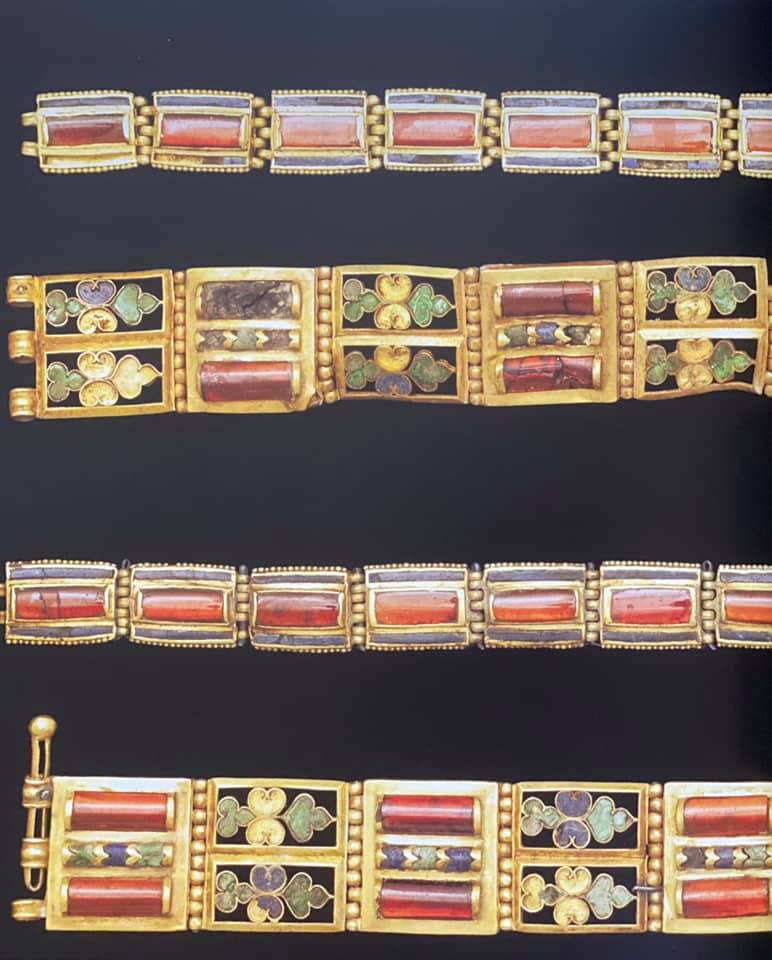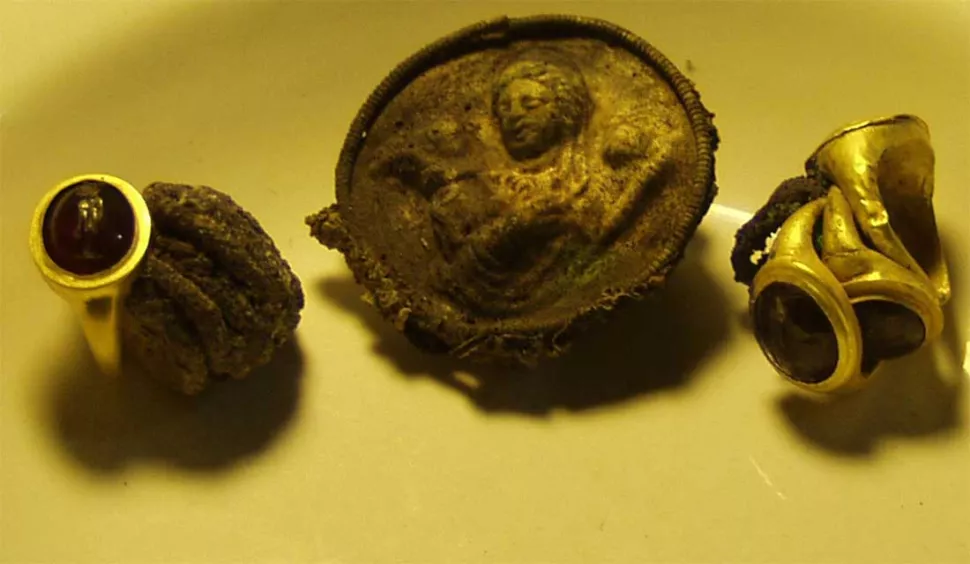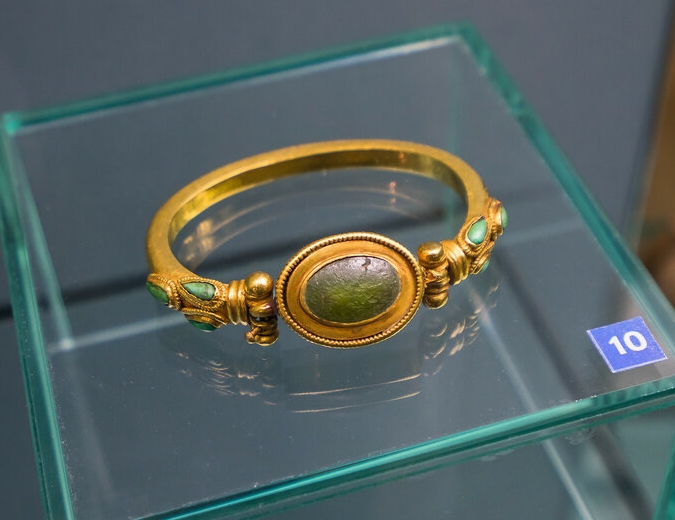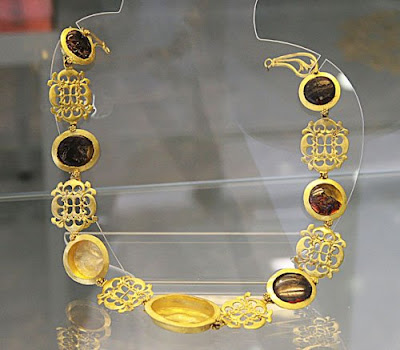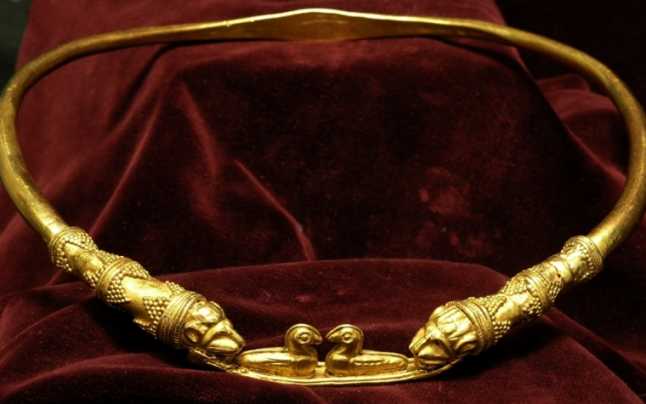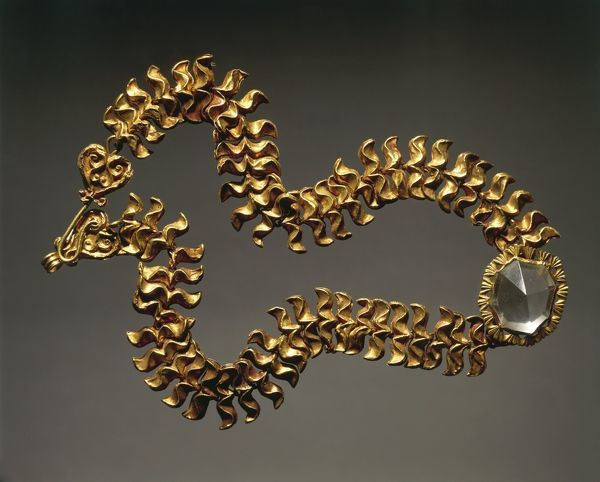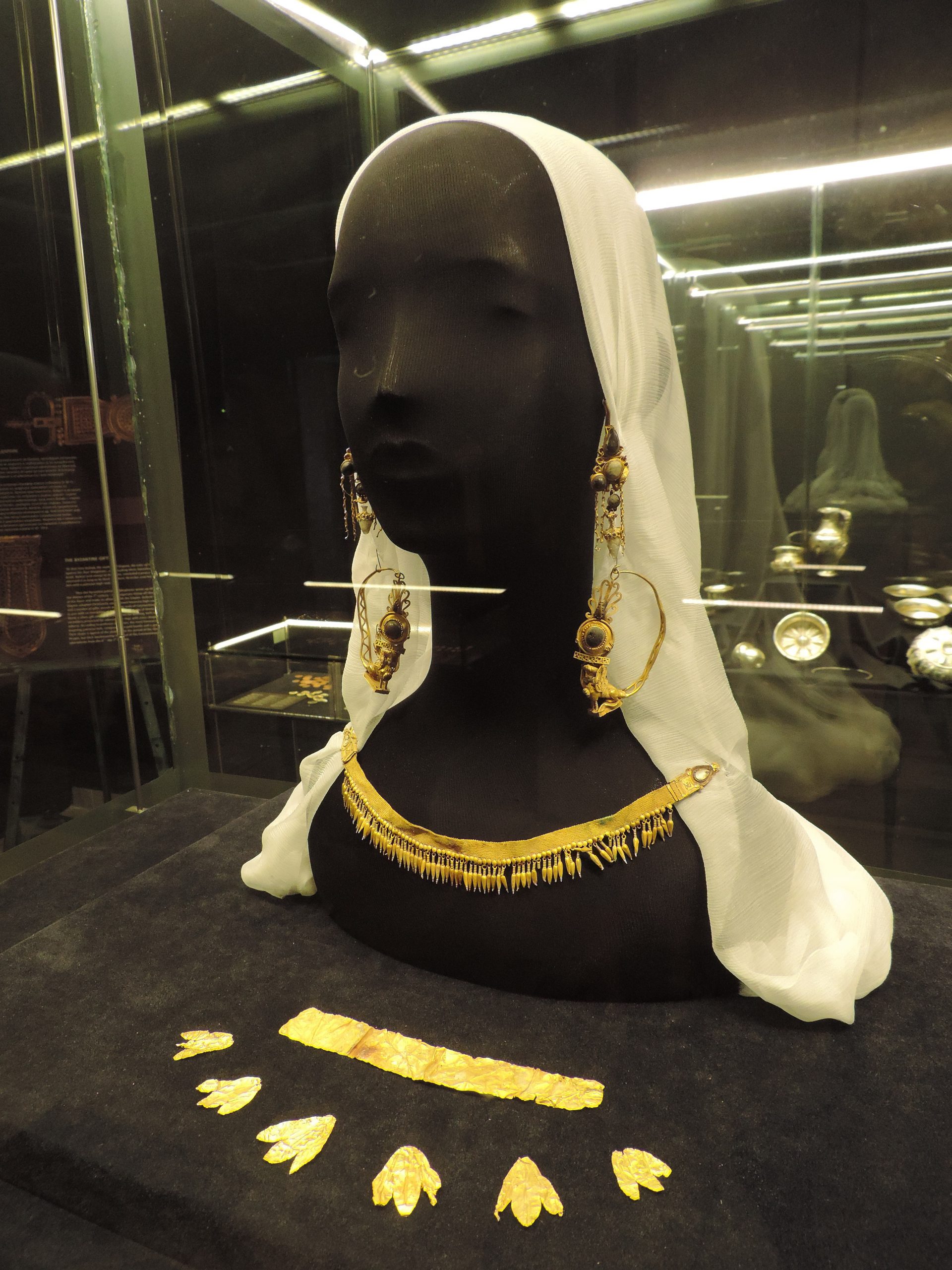
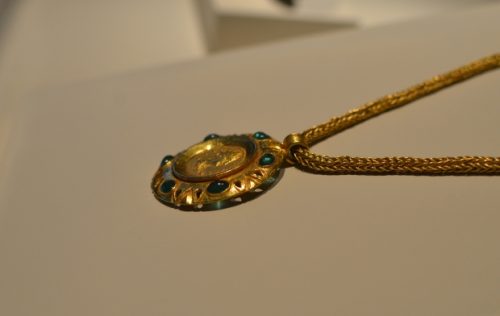




Medallion of Faustina the Elder, Roman, 200 CE
Exhibition Luxury: Treasures of the Roman Empire, the Nelson-Atkins Museum of Art, Kansas City 2016
the Ferrell Collection; gold and emerald
sources:
https://www.gemologyonline.com/Forum/phpBB2/viewtopic.php?f=27&t=23132
https://vestificasericata.wordpress.com/luxury-exhibit-jewelry/
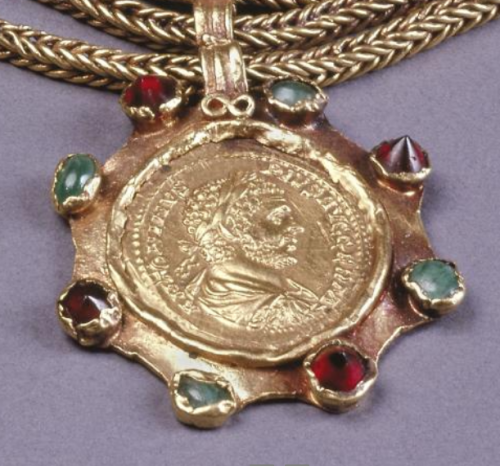

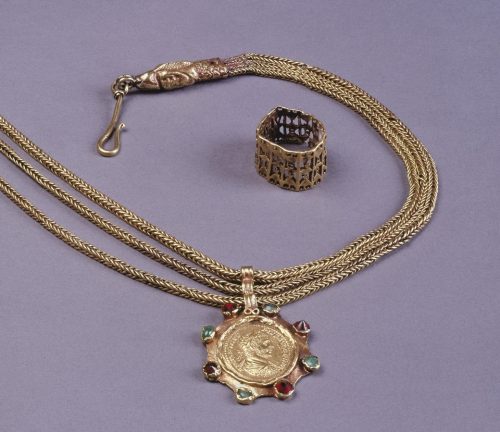
Necklace with a medallion made of gold with gemstones. In the middle there is a coin with a bust of Emperor Caracalla. Roman 3rd century; found Nikolaevo (Pleven) Bulgaria. Coin struck 198-217 CE, medallion made ca 249 CE.
In the National Institute of Archeology and Museum, inventory no. 4774
- Length: 46.6 cm
Diameter: 2.9 cm
Weight: 91.99 grams
about the ring >> https://www.bildindex.de/document/obj05161685
Literature:
“The Thracians”: The Metropolitan Museum of Art Bulletin, v. 35, no. 1 (Summer, 1977), https://www.metmuseum.org/
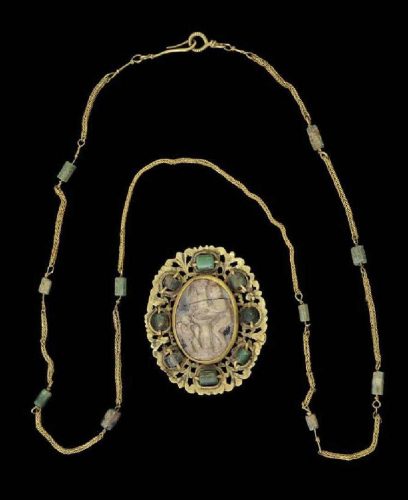
The cameo depicts Aphrodite & Eros in the ablution scene, at the sides of a bowl-fountain. From the Stathatos Collection @namuseumathens Source: “Byzantium Through the Centuries” Y. Pyatnitsky, pp. 340-341
https://www.academia.edu_Byzantium_Through_the_Centuries
Gold chain and pendant with emeralds and the glass cameo “Aphrodite and Eros” Roman Empire or Byzantium 4th c.
Medallion height 3.9 cm; the width of the medallion is 3.2 cm; the height of the cameo is 2.3 cm; cameo width 1.5 cm; buttoned chain length 22.5 cm; chain weight 5.5 g; pendant-medallion weight 6.5 g
Preservation: three small pieces of foil on the back of the medallion indicate a repair; the double strands closest to the clasp are missing beads
Provenance: Stathatos Collection National Archaeological Museum, Athens; Inv. No. Στ. 508
Literature: Amandry 1963. P. 283, 284. Cat. 202. Pl. 41
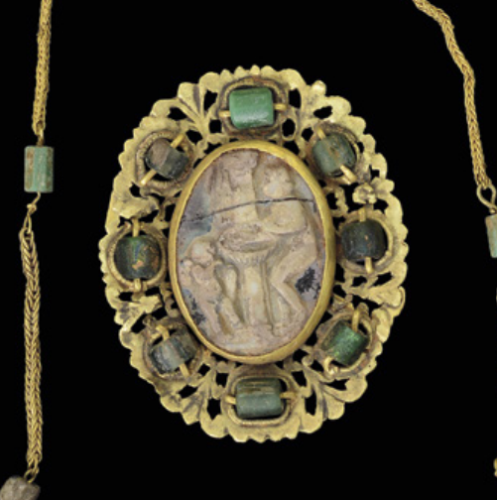
Stathatos Collection National Archaeological Museum, Athens
Inv. No. Στ. 508
—————–
Gold chain with ten emerald cylindrical beads and a glass cameo medallion. The gold chain consists of sections made using the loop-to-loop technique, which are connected at the ends with wires bent into a loop; Elongated emerald beads and one glass bead are suspended from the wires. The chain fastens with a hook and loop of twisted wire. The cast glass cameo is made as a medallion pendant. It is set in a gold slotted frame, decorated with palmettes, seven cylindrical emeralds and one glass inlay.
The cameo depicts Aphrodite and Eros at the sides of a bathing fountain mounted on a column in the center of the composition. A naked Aphrodite stands on the right, her knees are slightly bent, she covers her chest with her left hand, and lowers her right into the fluted bowl of the fountain. Left – Eros holds a vase in the form of an alabastron in his right hand. Behind the fountain, a small pedestal with a capital and draped overmatter-drapery is visible.
The image of Aphrodite and Eros near the bowl-fountain, a vessel that from ancient times to modern times was associated with washing, healing and, especially, with the ritual of purification, may be associated with ancient religious ideas. Perhaps it was believed that the medallion depicting Aphrodite and Eros in the ablution scene brings prosperity and good luck to the wearer in love affairs.
by М. Хидироглу; pp 340-341
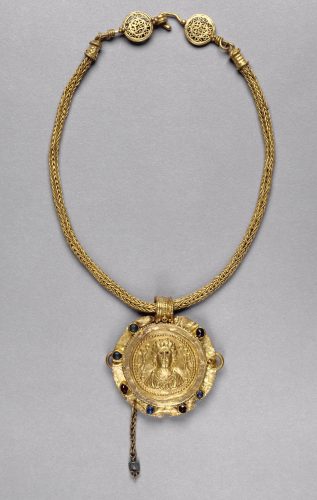

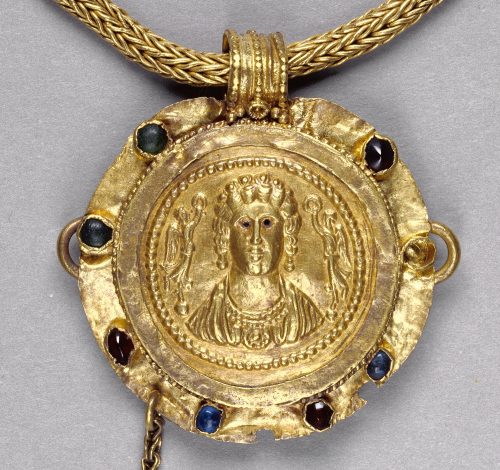
Chain and Pendant with the Bust of an Empress, possibly bust portrait of Aelia Flacilla, gold garnet, sapphire, glass. Ca. 379–395 CE https://www.getty.edu/
Note: the frame can be older, medalion could have been set later. (see the Caracalla coin in the) similar setting.
Two chain-pendants are missing. Two big loops indicate additional elements of the necklace.
“The repoussé medallion of this gold necklace shows a frontal bust of a middle-aged woman flanked by personifications of victory, who crown her with wreaths. The crowning figures, the woman’s pose, and the jewelry she wears, especially the diadem, suggest that she is a member of the imperial family, possibly Aelia Flacilla, wife of emperor Theodosius I. If this identification is correct, the medallion portrait dates to the 380s A.D. With its simplified facial detail, drilled staring eyes, and large head, the portrait is typical of the iconic style of much Late Roman art. The medallion was reworked a few decades after it was made: the outer frame with the settings holding the garnets and blue and green glass, the three pendant chains, and the two side rings are all later additions.
The chain of the necklace is ropelike, and the hook-and-eye clasp is decorated with openwork circlets as well as filigree and granulation. The chain shows particularly fine workmanship; the medallion does not.[???]
The discrepancy reveals that the two pieces were not created as a unit but nevertheless were joined in antiquity.” The Getty
 Pendant with an intaglio Zeus Enthroned Created: The Northern Black Sea Region. 2nd century https://www.hermitagemuseum.org |  Pendant with an intaglio – Fortuna Created: The Northern Black Sea Region. 2nd century https://www.hermitagemuseum.org |



